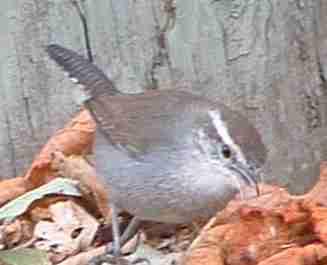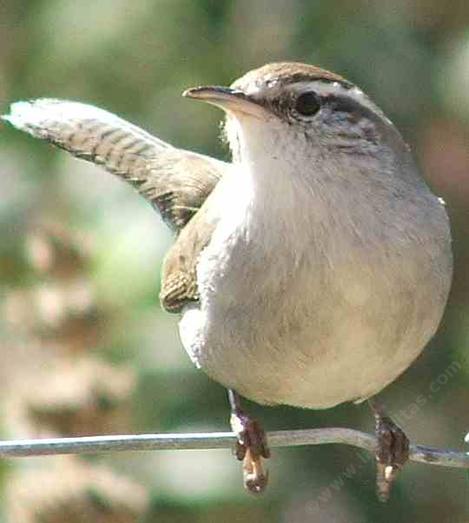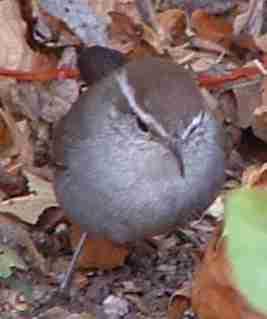Bewick's Wren, Thryomanes bewickii
These little birds have quite a personality. They are very defensive of their territory which are usually about two and a half acres. Their defensive behavior and their overly large white eye brows make them formidably for their small size (about five inches in length.) They often flip their tail up and down or hold it at a very high angle to their body, giving them a stern appearance.Diet of the Bewick's Wren
The Bewick's Wren feeds mainly on insects and spiders as well as other arthropods. They forage mainly by glean from the lower branches of trees or from shrubs. The Bewick's Wren in the picture above is picking insects that have been attracted to fallen apples. They will occasionally eat seeds. They prefer to glean in dense foliage where are they are less visible to hawks and other predators
Habitat/ Plant community of the Bewick's Wren
The Bewick's Wren is found mostly in dense shrubby habitats especially Chaparral. However it also uses oak woodland when there is dense under growth and Pinyon-juniper woodland when intermixed with shrubs.
Migration of the Bewick's Wren
The Bewick's wren is a resident. However, some populations near mountains may take advantage of warmer climates and the temporary abundance of food at higher elevations in spring.
Range of the Bewick's Wren
The Bewick's Wren is found throughout most of California except in the deserts of the south east and they high elevations of the Sierra Nevada mountain range.
Nesting habitat of the Bewick's Wren
The Bewick's Wren is a secondary cavity nester. That is they do not actually excavate their own holes. In this case they actually prefer naturally occurring cavities. Although they will nest in old woodpecker cavities, their nesting sites do not necessarily have to be in trees. In fact they prefer to nest near or on the ground. They will also nest in rock crevices or on man made structures.
How to attract the Bewick's Wren to your garden
To attract the Bewick's wren to your garden plant chaparral plants. This is its main habitat and many species are very drought tolerant and excellent for California gardens. A good choice for your garden ia Manzanita species. At the Nursery in Santa Margarita they use Big Berry Manzanita, Arctostaphylos glauca. They seem to favor north facing slopes in the chaparral. These plant communities are denser and moister. Mountain Mahogany, Cercocarpus betuloides, Toyon, Heteromeles arbutifolia and Scrub Oak, Quercus berberidifolia, are also dominant species in this plant community and used by the Bewick's Wren for cover and foraging sites. Another shrub that they are often found in is Golden current, Ribes aureum gracillimum. This is a thicket forming shrub with bright yellow flowers and black berries that is a favorite of many birds. Occasionally they will eat fruits from Elderberry, Sambucus mexicana and Poison Oak, Toxicodendron diversilobum. Also they will occasionally eat seeds of Sumac, Rhus spp, (RHUS) Malosma laurina, and Fiddle neck, Amsinckia spp.






